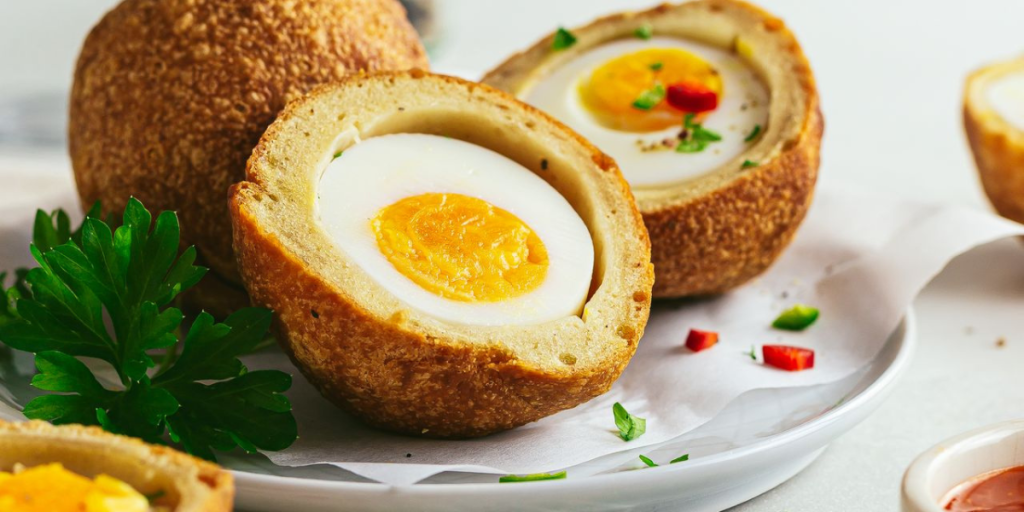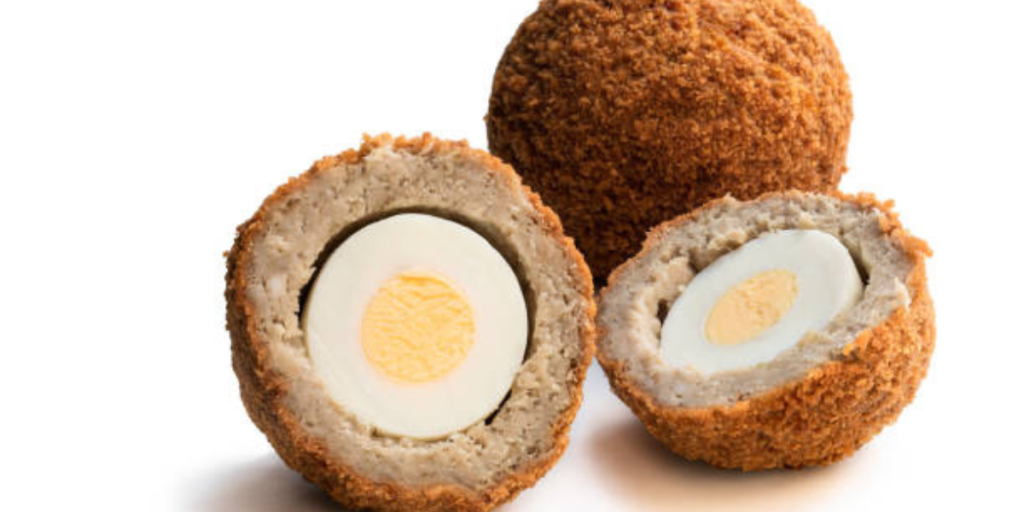Table of Contents
Nigerian eggrolls are a beloved street food and snack enjoyed by people of all ages across the country. These treats consist of a hard-boiled egg wrapped in seasoned dough and then deep-fried to golden perfection. Their appeal lies not only in their taste but also in their versatility, as they can be enjoyed as a snack, breakfast option, or even a lunchbox item. Making eggrolls at home allows you to experiment with the recipe, ensuring that they’re fresher, healthier, and suited to your personal preferences.
Eggrolls have become part of Nigeria’s rich food culture, often found alongside other popular snacks like puff-puff and chin chin. Understanding the art of making eggrolls will not only elevate your culinary skills but also bring a slice of authentic Nigerian street food into your kitchen.
Ingredients Needed for 1kg Eggroll Recipe

For eggrolls made with 1kg of flour, these ingredients will create a delicious, golden-brown result:
- 1kg all-purpose flour: This ingredient serves as the base, creating a solid structure for the dough.
- 200g margarine or butter: The fat content contributes to a tender and flaky dough.
- 150g sugar: Sweetens the dough slightly, balancing the savory taste of the egg.
- 20-24 hard-boiled eggs: Provides the classic filling and nutritional value.
- 2 teaspoons baking powder: Ensures a light and fluffy dough by adding some leavening.
- 1 teaspoon ground nutmeg: Adds warmth and a hint of spice to the dough.
- 1 teaspoon salt: Balances out the sweetness, making the flavors pop.
- 200ml milk or water: Acts as the liquid binder, with milk providing a richer dough.
- Vegetable oil for deep frying: Sufficient oil to ensure the eggrolls can float freely during frying.
Additional Ingredient Insights
The traditional ingredients are straightforward, but some cooks opt to add a few extra touches for a unique spin:
- Spices like cinnamon or ginger can be included for extra depth of flavor.
- Substituting half the flour with whole wheat flour for a more nutritious option.
- Incorporating herbs like parsley or thyme for a savory touch.
- Efo Riro Recipe: A Delicious African Dish best of 2024
Step-by-Step Preparation Guide
Preparing the Eggs
- Boiling the Eggs:
- Begin by boiling the eggs. Place them in a pot, cover with cold water, and bring to a boil. Once boiling, reduce the heat and simmer for 10-12 minutes.
- Transfer the boiled eggs to ice-cold water to stop the cooking process, ensuring the yolks stay bright yellow without developing a grayish tint. This method also makes peeling the eggs much easier.
- Pat the peeled eggs dry with a paper towel to remove any excess moisture before wrapping them in dough.
Making the Dough
- Mixing the Dry Ingredients:
- In a large bowl, sift the flour to remove lumps, then add the sugar, baking powder, salt, and nutmeg.
- Rub the margarine or butter into the flour mixture using your fingertips until it becomes crumbly. This step helps create a flaky texture.
- Combining Wet Ingredients:
- Gradually mix in the milk or water, stirring with a wooden spoon or your hands until the dough comes together. Knead lightly for about 5 minutes, aiming for a smooth and elastic consistency.
- Cover the dough with a clean kitchen towel or plastic wrap and let it rest for at least 15-30 minutes. This step relaxes the gluten and ensures a more workable dough.
Shaping the Eggrolls
- Portioning the Dough:
- After resting, divide the dough into 20-24 portions.
- Flatten each portion into a disk large enough to wrap around an egg. Place an egg in the center, then fold the dough over it, sealing any gaps.
- Roll each dough-wrapped egg gently between your palms to ensure smooth, even coverage.
Frying Techniques for Perfect Eggrolls
The frying process is key to achieving the perfect texture—crisp on the outside, soft and fluffy inside:
- Preheat the Oil:
- Heat enough vegetable oil in a deep pot to fully submerge the eggrolls. Aim for an oil temperature of about 170°C (340°F). Use a thermometer for accuracy.
- Fry in Small Batches:
- Adding too many eggrolls at once can lower the oil’s temperature, resulting in uneven cooking. Fry a few eggrolls at a time for the best results.
- Turn Occasionally:
- Use a slotted spoon to turn the eggrolls while frying, allowing for even browning on all sides. This should take around 5-8 minutes.
- Drain on Paper Towels:
- Place the fried eggrolls on paper towels to absorb excess oil, ensuring a crisp finish.
Tips and Tricks for Best Results
Here are some advanced tips to elevate your eggroll-making experience:
- Monitor the Dough’s Thickness: Aim for a dough thickness of about 1/4 inch to ensure it cooks evenly without becoming too thick or thin.
- Test the Oil Temperature: If you don’t have a thermometer, drop a small piece of dough into the oil. It should sizzle and rise slowly to the surface.
- Maintain a Steady Frying Temperature: Adjust the heat to keep the oil at a consistent temperature, avoiding sudden spikes or drops.
- Season the Dough with Personal Preferences: Add herbs, spices, or even grated cheese to the dough for a customized flavor profile.
Common Mistakes When Making Eggrolls
Avoid these common pitfalls:
- Using Cold Eggs: Wrapping eggs that are too cold may cause the dough to crack. Let the eggs reach room temperature before wrapping.
- Thick Dough Wrapping: If the dough layer is too thick, it won’t cook thoroughly. Aim for an even and thin covering.
- Overcrowding the Fryer: This reduces oil temperature, causing greasy, undercooked eggrolls.
Health Benefits of the Ingredients
Nigerian eggrolls can be a part of a balanced diet when made with fresh, quality ingredients:
- Eggs: are nutrient-dense, providing high-quality protein, vitamins A, D, E, and essential fatty acids.
- Nutmeg: contains antioxidants and may help with digestion, making it a beneficial addition.
- Margarine or butter: in moderation can provide essential fats, while substituting with healthier oils like olive oil can reduce saturated fat content.
Serving Suggestions and Pairings

Eggrolls can be paired with various dips and side dishes:
- Spicy Pepper Sauce: The heat from the sauce complements the mild flavors of the eggroll.
- Fresh Fruit Juice or Zobo: A refreshing drink balances the richness of the fried dough.
- Tomato-Based Stew: Commonly served as a dip for added moisture and flavor.
Variations of Eggrolls
Variations in Nigeria
While the traditional Nigerian eggroll is beloved, regional differences exist. Here are a few variations:
- Spicy Eggrolls: In regions where spicy food is favored, some recipes incorporate chili powder or finely chopped scotch bonnet peppers into the dough or egg filling for an extra kick.
- Vegetable-Filled Eggrolls: Some cooks opt to add finely chopped vegetables like carrots, bell peppers, or onions to the filling, creating a nutritious twist.
- Cheesy Eggrolls: Adding grated cheese inside the eggroll can create a delicious, gooey center, particularly popular among children.
Variations in Africa
Across Africa, different countries have their own versions of similar snacks:
- South African “Bunny Chow”: While not an eggroll, this dish features bread hollowed out and filled with curry, showcasing how bread can be used creatively to wrap various fillings.
- Ghanaian “Kelewele”: Although it focuses on spiced fried plantains, it highlights how different African cuisines explore fried foods, often spiced or flavored differently.
- Tunisian “Brik”: A pastry that often contains an egg, herbs, and spices, brik is wrapped in thin dough and deep-fried, showcasing the influence of Mediterranean cuisine in North Africa.
Variations Around the World
Globally, many cultures enjoy similar concepts of wrapping food in dough. Here are a few notable examples:
- Chinese “Spring Rolls”: These are thin wrappers filled with a variety of ingredients, including vegetables and proteins, and then deep-fried. While they differ in texture and taste, the concept of a wrapped filling is similar.
- Japanese “Onigiri”: Although made from rice instead of dough, these rice balls often contain fillings and are wrapped in nori, offering a different but parallel approach to wrapped snacks.
- Indian “Samosas”: These are fried or baked pastry pockets filled with spiced potatoes, peas, and sometimes meat, similar in concept to the eggrolls but distinct in flavor and preparation methods.
- Latin American “Empanadas”: These stuffed pastries can be sweet or savory and are baked or fried. Variations exist across many countries, each with unique fillings and spices, showcasing the global love for hand-held snacks.
Frequently Asked Questions (FAQs)

- Can I bake eggrolls instead of frying them? Yes, you can bake eggrolls for a healthier option. Preheat your oven to 180°C (350°F), place the eggrolls on a baking sheet lined with parchment paper, and lightly brush them with oil. Bake for about 20-25 minutes or until golden brown.
- What can I use as a substitute for margarine? You can use unsalted butter, coconut oil, or any vegetable oil as a substitute for margarine in your eggroll dough.
- How long can I store leftover eggrolls? Leftover eggrolls can be stored in an airtight container in the refrigerator for up to three days. To reheat, place them in an oven at 180°C (350°F) until heated through and crispy.
- Can I freeze eggrolls? Yes, eggrolls can be frozen. After wrapping them in dough, place them in a single layer on a baking sheet to freeze. Once frozen, transfer them to a freezer-safe bag or container. Fry them directly from frozen, adding a couple of extra minutes to the cooking time.
- What can I serve with eggrolls? Eggrolls pair well with a variety of dipping sauces, such as spicy pepper sauce, ketchup, or a yogurt-based dip. They can also be enjoyed with a side of salad for a complete meal.
- Are eggrolls suitable for vegetarians? Traditional Nigerian eggrolls contain eggs; however, you can create vegetarian variations by using tofu or vegetable fillings instead of eggs.
Conclusion
Mastering the art of making Nigerian eggrolls can transform your kitchen into a bustling street food vendor. With their delightful combination of flavors and textures, they offer a taste of Nigeria’s rich culinary heritage. Whether you enjoy them as a snack, breakfast, or a party treat, eggrolls are sure to impress. By following this comprehensive guide, you’re well on your way to becoming an eggroll expert, ready to share this beloved dish with friends and family.






















This is a good guide. However, you did not mention whether water/milk should be cold, be at room temperature or warm. It will help to know. Thanks for sharing.